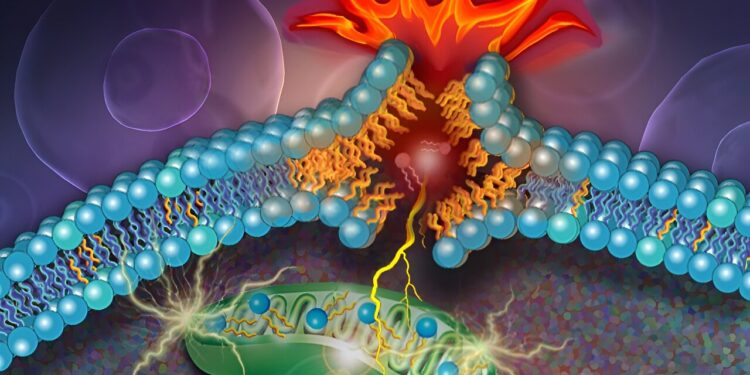Illustration of a diPUFA phospholipid, a type of lipid with two polyunsaturated fatty acyl tails, passing through the outer lipid layer of a cell when the cell dies. New research has shown that diPUFA phospholipids are a key driver of a form of cell death known as ferroptosis. Credit: Nicoletta Barolini/Columbia University
Columbia researchers have discovered that a rare type of lipid is a key driver of ferroptosis, a form of cell death discovered by Columbia professor Brent Stockwell.
The results, published in Cellprovide new details about how cells die during ferroptosis and could improve understanding of how to stop ferroptosis in contexts where it occurs harmfully (in neurodegenerative diseases, for example) or induce in contexts where it could be useful, such as its use to kill dangerous cancer cells.
The new research found that a rare type of lipid with two polyunsaturated fatty acyl tails, called diPUFA phospholipid, was present in various settings where ferroptosis occurs, including in aging brains and brain tissue affected by Huntington’s disease. The finding indicates that the lipid is effective in promoting ferroptosis.
The research was conducted by faculty in the Department of Biological Sciences, Department of Chemistry and Columbia University Irving Medical Center.
Stockwell first discovered ferroptosis in 2012, when he discovered that some cells die because their lipid layers collapse, an unusual form of cell death that differs from the most common form, which begins with the formation blisters on the outer surface of the cell.
Since this discovery, researchers in Stockwell’s lab and elsewhere have continued to study ferroptosis, discovering that it can occur naturally in aging cells, in pathological contexts, and that it can be induced to treat disease.
Another paper published in February 2024 with several co-authors revealed that a gene called PHLDA2 can sometimes promote ferroptosis by attacking a different lipid, and that this gene can block the formation of certain tumors. Together, these papers show that specific lipids promote ferroptosis, so it is important to define driver lipids in specific cancers.
“The discovery that these diPUFA lipids are important factors in ferroptosis deepens our understanding of this form of cell death and the role of these lipids in controlling a cell’s homeostasis in general,” Stockwell said.
“Harnessing these lipids could eventually help us identify where ferroptosis has occurred and deliberately manipulate them to induce or stop cell death. This may begin to give us both understanding and power to control cell death.
More information:
Phospholipids with two polyunsaturated fatty acyl tails promote ferroptosis, Cell (2024). DOI: 10.1016/j.cell.2024.01.030. www.cell.com/cell/fulltext/S0092-8674(24)00067-9
Journal information:
Cell
Provided by Columbia University
Quote: Researchers discover that a rare fat molecule contributes to cell death (February 15, 2024) retrieved February 15, 2024 from
This document is subject to copyright. Apart from fair use for private study or research purposes, no part may be reproduced without written permission. The content is provided for information only.



